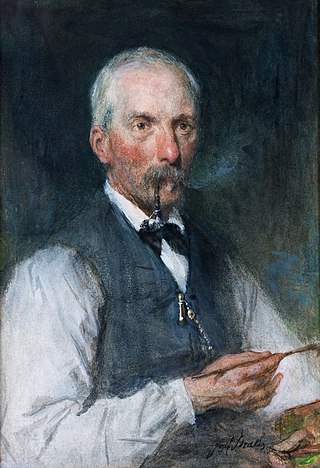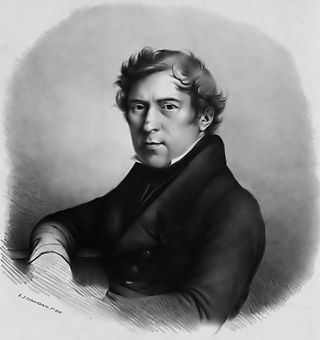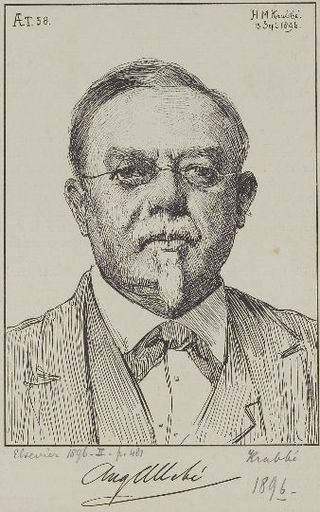Jo Koster (1868-1944) was a Dutch Neo-Impressionist and Pointillist painter. [1] [2]
Jo Koster (1868-1944) was a Dutch Neo-Impressionist and Pointillist painter. [1] [2]
Koster was born on 16 April 1868 in Kampen, Netherlands. [3] She was the third of eight children. [4] Her early education from 1881 through 1885 was in Dordrecht where she excelled in art and music. [5] In 1885 she moved to Amsterdam [6] where she attended the Rijksnormaalschool voor Tekenonderwijs (National Normal School for Drawing Teachers). In 1888 she moved to Rotterdam [7] where she attended the Tekenacademie (Drawing Academy). [8] In 1891 she exhibited in her first group show. [9]
In 1894 Koster received a fellowship to study in Brussels and Paris. [10] In Paris she studied at the Académie Julian and the Académie Colarossi. [8] She spent several years at Ernest Blanc-Garin's workshop in Brussels. There she became acquainted with the work of artists involved with Les XX and La Libre Esthétique . [11] During this period Koster began painting portraits which would become a source of income for her. [10]
Koster returned to Holland in 1897, settling in The Hague. She was engaged for a time, but decided not to marry. [12] In 1899 she moved to Laren where she became friends with the painter Adrienne van Rees-Dutilh(1876-1959). [13] In 1901 she exhibited her work at the annual Kunstenaarsvereniging Sint Lucas show at the Stedelijk Museum Amsterdam. The art dealer, Nico van Harpen (1858-1931) took notice of her and sold her art to American and South African collectors. Koster also began a friendship with Lidy van Bosse, who was able to arrange for portrait commissions which provided income. [14]
In 1902 Koster relocated to Zwolle. [14] She studied with Henk Bremmer who was also a supporter of her work. [15] At this time Koster's work was commanding high prices. She was working in a style influenced by her French contemporaries as well as a naturalistic style. [16]
In 1910 Koster settled in Hattem which had a lively arts scene. Two of her works were included in the 1913 show De Vrouw 1813–1913 (Women 1813-1913) in Amsterdam which celebrated the hundredth anniversary of the Netherlands liberation from French occupation. Around this time Koster was moving towards a more Pointillist style and she was also finding work as an illlustrator. [17]
In the early part of the 20th century Koster traveled to England and Italy. [15] After World War I she traveled to Germany, Switzerland, and France. She spent much of 1923 in Italy, where she wrote travel articles. [18] In the late 1920s she spent her summers in Brittany where she met the New Zealand painters Iva McEldowney and Vera Vial. In 1930 she traveled through Europe with McEldowney and Vial. [19] In 1932 she traveled to Selva, Mallorca with Geertruida van Hettinga Tromp. [20]
Koster lived in The Hague from 1934 through 1943. She participated in group shows in the 1940s receiving good reviews from critics. In the winter of 1939-1940 four works of Koster's were included in the show Onze Kunst van Heden (Our Art of Today) at the Rijksmuseum. [21]
In 1942, with the threat of a German invasion, Koster left The Hague along with her friend Geertruida van Hettinga Tromp, settling in Zaltbommel at the home of Tromp's sister. In late 1943 she visited Lidy van Spengler in Heelsum. She fell ill there and died on 15 April 1944. [2] [21] [3]
Koster was a member of and exhibited with Arti et Amicitiae, the Kunstenaarsvereniging Sint Lucas, the Vereeniging van Beeldende Kunstenaars, De Rotterdammers (Association of Visual Artists), and the Pulchri Studio. From 1891 through 1940 Koster participated in many group and solo exhibitions in Holland from a solo exhibit at the Museum De Lakenhal in 1898, through a group exhibition at the Rijksmuseum in 1939. [22]
Her work is in the collections of the Kröller-Müller Museum and the Rijksmuseum. [2] Koster's work has been exhibited posthumously in the 1968 show Nedrelanse Erfenis (Dutch Heritage) at the Pretoria Art Museum, in 1988 at the Kunsthandel Les Beaux Arts The Hague. In 1990 she was included in the exhibition Schilders rond Bremmer (Painters around Bremmer) at The Bremmerhuis. The same year her work was included in the traveling exhibition Het Boereninterieur in de Nederlandse schilderkunst (The Peasant Interior in Dutch Painting). In 1991 she was included in Schilders van Hattem (Painters of Hattem) at the Voerman Museum Hattem . In 2001 she was included in the exhibition Het netwerk van H. P. Bremmer (The Network of H. P. Bremmer) presented by the Hannema-de Stuers Foundation. In 2003 she was the subject of the exhibition Jo Koster 1868-1944: een zwervend bestaan (Jo Koster 1868-1944: A Wandering Existence) at the Stedelijk Museum Zwolle. [22]

The Hague School is a group of artists who lived and worked in The Hague between 1860 and 1890. Their work was heavily influenced by the realist painters of the French Barbizon school. The painters of the Hague school generally made use of relatively somber colors, which is why the Hague School is sometimes called the Gray School.

Jan Hendrik Weissenbruch, also known as Hendrik Johannes Weissenbruch was a Dutch painter of the Hague School. He is noted especially for his watercolours.

Andreas Schelfhout (1787–1870) was a Dutch painter, etcher and lithographer, known for his landscape paintings.

Paul Joseph Constantin Gabriël or Paul Gabriël was a painter, draftsman, watercolorist, and etcher who belonged to the Hague School.

Julius Jacobus van de Sande Bakhuyzen was a Dutch etcher and painter in the Hague School. He was a member of a number of artists' associations, such as Arti et Amicitiae and Pulchri Studio.

The Amsterdamse Joffers were a group of women artists who met weekly in Amsterdam at the end of the 19th and beginning of the 20th century. They supported each other in their professional careers. Most of them were students of the Rijksakademie van beeldende kunsten and belonged to the movement of the Amsterdam Impressionists. Each one became a successful artist. As a group they contributed to the social acceptance in the Netherlands of women becoming professional artists.

August Allebé was an artist and teacher from the Northern Netherlands. His early paintings were in a romantic style, but in his later work he was an exponent of realism and impressionism. He was a major initiator and promoter of Amsterdam Impressionism, the artist's association St. Lucas, and the movement of the Amsterdamse Joffers. Amsterdam Impressionism – sometimes referred to by art historians as the School of Allebé – was the counterflow to the very strong Hague School in the movement of Dutch Impressionism. As a professor at the Royal Academy of Amsterdam he fostered a cosmopolitan attitude toward art and the promotion and motivation of his students, and provided a significant stimulus to developments in modern art.

Pieter Biesboer, is a Dutch art historian and prolific writer on 17th-century Dutch art. His specialty is art from Haarlem.

Johannes Anthonie Balthasar Stroebel, was a Dutch painter.

Willink van Collenprijs is a former Dutch art award, which was awarded for the first time in 1880 by the Sociëteit Arti et Amicitiae. It was intended as an encouragement award for young artists, and was considered as a national counterpart to the Paris Salon. Its existence of more than 71 years proves the success of Amsterdam's art policy. For many of its winners, it was a valuable boost to their careers in the Dutch art world. Some of the prize winners were also recognized abroad and remain well known today.

Jaap Schreurs was a Dutch painter and graphic artist in the neo-figurative style.

Smiling Girl, a Courtesan, Holding an Obscene Image, also known in Dutch as Een Laggende Vrouw met een naakte Pourtraitje in de Hand, waar onder divisje staat or Jonge vrouw met een medaillon, is an oil painting on canvas by Gerard van Honthorst, created in 1625. It is held in the Saint Louis Art Museum where it is on view in Gallery 236.
Pieternella "Nelly" Cornelia Goedewaagen was a Dutch painter and printmaker.
Tjitske Geertruida Maria van Hettinga Tromp (1872-1962) was a Dutch painter.

Cornelia "Corrie" Johanna Pabst (1865–1943) was a Dutch artist.

Cecilia Maria Elisabeth de Ranitz (1880-1970) was a Dutch painter.

Anna Julia "Julie" de Graag, was born at Gorinchem on 18 July 1877 and died at The Hague on 2 February 1924. She was a Dutch watercolourist, printmaker, and painter.

Old Woman Reading, also known as Old Woman Reading a Lectionary, is an oil painting by the Dutch painter Gerrit Dou, made c. 1631–1632. In the past the work was attributed to Rembrandt and was titled Rembrandt's Mother, but this attribution has long been rejected. The portrait has been part of the collection of the Rijksmuseum, in Amsterdam, since November 1912.
Quentin Buvelot is a Dutch art historian. He works as the chief curator at the Mauritshuis in The Hague, and is regarded as a specialist in the painting of the Dutch Golden Age.

Ariane van Suchtelen is a Dutch art historian and museum curator, currently at the Mauritshuis.